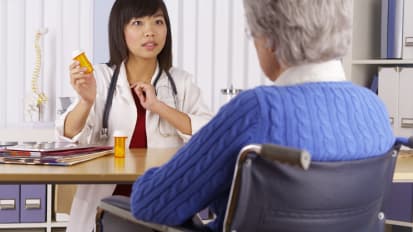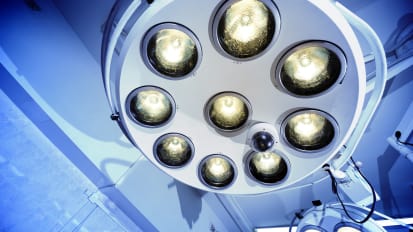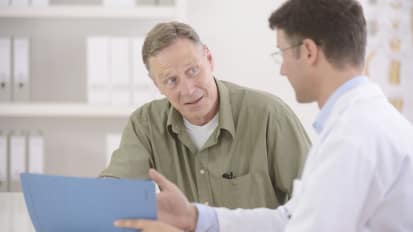Chapters
Transcript
[MUSIC PLAYING]
AL: I'm a peer mentor with the U of M transplant team, volunteer. I'm also a former dialysis patient. I'm also a kidney transplant recipient. My journey started when I was pretty young. I was 14 years old, and I got injured in a high school football game. I had made a catch, and I landed on the ball, and I bruised my spleen.
Well, they took me to the hospital, and they said, well, you know what? You only have one functioning kidney. My mom was all freaked out, and we didn't know what quite to do. He said, well, just live your life normally, and things should be OK. Well, it worked great.
And then I turned 43 years old. That's almost 30 years after that. I got what's called "the cough," as my wife refers to it. So it was this just nagging cough for about a month. And finally I couldn't take it anymore. I went in to see the doctor. And I go in to see the doctor. She thinks it's allergy pills-- my little local town up by Owasso.
I go in. She gives me these allergy pills. I go home, I take the pills. I get up the next day, and, I mean, I could barely see. So I muddle my way down the back road to her office, and I go in. I go, man, there's something that's not right with this. I mean, I just feel awful. And so she takes my blood pressure. It's like 240 over 190. Over And then, all of a sudden, I'm riding in an ambulance into the hospital.
Well, I wasn't sure what was going on with that. So I was in the hospital in the emergency room, and they ran all kinds of tests and that. And pretty soon, they just rushed me up to ICU. And apparently-- I'm going by my wife's recollection on this, because I don't remember. I was in there for five days. In fact, they told her, make sure you get your family in line and get some plans together, is what they said to her. I don't remember this.
So we get through that, and all of a sudden I wake up, and I'm in this private room. And I look down, and I've got the catheter right there with the dialysis machine going. And so that really started my process. They never really determined what caused it. They think it could have been a bird flu or some kind of strain of virus, and then with the allergy medicine that exasperated that.
But it basically shut down my kidneys, or my kidney, I should say. And so the experience began. So my wife and I, we were talking with my parents. And I had a great, great social backing. I mean, my friends, my family were all behind us. We had a good plan together. We talked with our nephrologist, and we really didn't know what to expect.
And I've got to tell you, after that, after I got out of the hospital, I started dialysis, going to the clinic the next day in Owasso. I went to the Fresenius clinic up there. Small, 12-chair dialysis center. Absolutely the nicest people, because I didn't know what to expect. None of us had ever experienced anything like this. We're kind of scared. We're thinking, am I going to die? What's the deal?
And they were really good at working with myself, my nephrologist at the time from Owasso. We came together with a wonderful plan. We had just unbelievable positive energy from that entire staff. I just can't tell you how that helped me and really motivated me to get this done.
I did about six months on hemo, and it was getting to the point where I had to either get the fistula or I needed to go into PD. My nurse, a good friend of mine, Larry, he says, Al-- he goes, do the PD, man. He goes, you're not going to have those highs and lows. You're doing it every day. You're going to be more consistent. He goes, you're a great candidate for it.
So I said, OK, well, I'll try the peritoneal. And I did. And I did that for about a year. Did it at home, did the bag exchanges. They didn't have the cycler at the time. That was pretty new technology at that point. And I did it. You know, I felt pretty good. I mean, better than I did, obviously, when I was in the hospital.
But everything was kind of hazy to me. And a lot of people always ask me, how do you feel after you get the transplant versus how you feel when you're on dialysis? It's such a slow-moving thing, the disease, from my perspective anyway, that you get this haze, or the fog, we call it. It becomes your normal, all of a sudden.
We went with that. We got a plan. We made T-shirts that I needed a kidney. We gave them to 100 people throughout the state and the Midwest, to good friends and family. We went on social media. We did Facebook, Twitter, Instagram. They didn't have Snapchat at that point, but we would have used that too. And I had a lot of people that volunteered to give me a kidney.
I mean, it was the most emotional thing ever. But unfortunately, a lot of them were just disqualified for whatever reason. Either it was from the phone interview, or coming down and getting the physical interview with the doctors and that. I don't remember the exact number, but I think it was 13 or 14 people volunteered to do that. And most of those, they were discarded for whatever reason.
So we just continued to do hope and say, we can get by with this for right now. This seems to be working. And then, all of a sudden, my sister-in-law stepped up. And she decided to donate a kidney to me. Well, unfortunately, we weren't the same blood type. So what happened then was we figured, well, what can we do? And then I was talking with my coordinator, and she said, well, we could try this paired donation program that they have here at U of M.
And so we looked at that. We set it up. It was about three months after we initially went through that that we had set up what we call a chain. So my sister-in-law would donate her kidney to somebody else, and then their donor would donate to me. But we had a three-person chain in the first one. And we were getting really close. We were about a week away. And then, all of a sudden, the chain broke. They didn't say why, but you know that happens.
So we went another couple months, and then we had another chain together. And the chain-- that time, it was about three days after we established the chain, so it wasn't as bad, but they called and said, unfortunately, that chain broke. Well, two weeks later, after that, we finally got the chain that worked.
And my sister-in-law donated her kidney to somebody down in Texas at Baylor University. And then I believe one went from Baylor to New York, one from New York to Illinois, Illinois back down to Texas, I think in San Antonio, and then that one came back up to me. And this was all on the same day, I mean, which was amazing. So you've got kidneys flying all over the country. Just crazy.
So my sister-in-law went in on that Friday. And it was the 10th of August in 2012. And she went in at 5:30 in the morning. And they said, well, you don't need to come in with her. And I said, bull. No way. I'm coming in. She's doing this for me. So she went in at about 5:30 in the morning, and then they took her kidney and got that rolling. I went into the surgery, I think, about 9:30 that night.
And they put the new kidney in, and it's amazing. I mean, if you can get your patients to get qualified for this, totally do it, anything you can do. And I know you guys work hard, and you do a great job. And it means a lot to the patients, it really does. They're kind of pissed off sometimes, they got mad sometimes, you get sick of doing that. But they stuck with you, and it's almost like a family. And I'm sure you guys feel that when you see that.
But I will tell you, the instant I woke up, and they were wheeling me up to the fifth floor here, I looked and I saw this painting on the wall. They were pushing me in the stretcher. And I looked, and the colors were so vibrant that it was just unbelievable. And so, when anybody asked me, what's the difference between once you get the transplant and doing dialysis, I said I look at it this way.
Back in college, I used to a party a little bit, like most people did. And I say, when you're doing dialysis, you're kind of in a fog. It's like you're hung over. And then, all of a sudden, you get that transplant, and you're naturally filtering those toxins yourself. Man, you're just clear, you're alert. I mean, it was just amazing.
I mean, I'm still a little buzzed up from the pain meds and whatnot, but you could definitely tell that you could see things differently. You could smell things, and even just drinking the ginger ale, you get your taste back. It's just amazing. I mean, it was an incredible experience.
I'll say the biggest thing, for me, the two biggest things I learned out of this whole experience, from this up to that point was, one, it was always hard for me to take help. I was a really independent person. I ran a big box retail for 30 years. And as a store director, I was always kind of an independent dude. I wanted to help other people and not get help. And to accept the help was a challenge at first. And look at how grateful I am now.
So I'm thinking, well, how can I give back? And that's when my nephrologist here, Dr. Norman, said, why don't you consider being a peer mentor? And so I said, well, yeah. That seems like a pretty cool opportunity. So I had my transplant on August 10 of 2012. I healed up pretty good from that. I played golf at the end of September. October, I was in the peer mentor class getting trained. And then we went out and talked to a lot of different patients and people.
A lot of different things that peer mentors do-- there's the education class, obviously. I sit in the outreach up in Lansing because it's right by my house. So I do that once a month. The other thing we do is what we call transplant expos where we come, actually, to your center-- we probably have been to a lot of your centers before. We come, and we actually talk with the patients about the experience.
I'm not a medical person at all, but I tell them about the patient perspective and some things that I used to get through the experience that maybe give them a little bit of hope, at least for the day, if not longer. And that's the most rewarding piece of it for me. You also have-- they run the PATH program. And there's a lot of different things you can do.
I like the people that you can give a little bit of joy to that are sitting in the chair and don't have a lot of hope at times. And I realize I'm very fortunate, because I had a great support system. These people were all behind me. And I know that's like 1% of the people, and I get that. So it's good to just talk to them and try to give them a little bit of encouragement, try to give them a little bit of hope, and move them forward in the process.
And hopefully you can see them up on the fifth floor when they're recovering. And that's kind of rewarding to do as well, do rounds. I used to do that all the time. I only really do that now about once a year, to come up to do the rounds. But I did run into somebody I met in a dialysis center. And they had his kidney. He was up on the fifth floor. And it was great to see his response to that process. So it kind of came full circle for me at that point.
To me, I wouldn't want to get sick in the first place. But you do, and you can't control that. And I learned a lot from the experience. I really did, and it's really helped me to look at things differently. The second thing I learned is I live every day. I took a lot for granted, like, oh, I missed a lot of family things because I was working all the time. And now, I put the family first. And I mean, it really just changed my perspective just on life.
I'm really thankful for that process. So you guys do an outstanding job. And that person in that chair probably doesn't go home to-- a lot of them don't go to the same type of home or living environment that we're in. Some do, some don't. And it's important just to keep them positive as best you can.
It meant the world to me with my dialysis team. I mean, I've got to tell you. They told me when to get the insurance at the right time, working with the social worker, the treatment coordinator, my nurse Larry getting me on PD at the right time. And I mean, that was just absolutely unbelievable.
As far as the pain from the transplant-- tolerable. I mean, I don't know. My wife tells me I have a high threshold of pain, so I didn't think it was too bad. The thing that hurt worse is when they cut that peritoneal tube out of you, because it's right on the muscle. And you're just sore for about two weeks, because every time you bend you can feel that.
But a funny story, just real quick, is the-- after we got home we were at the hospital. We had it Friday night. I was home Monday morning, on the couch. And they tell you not to move the bandage. What's the first thing I'm doing? Hey, come on, honey. Pull the bandage. Let's take a look at that bad boy. And so she's looking. It's all swollen, because they put the kidney right in the front. Mine's right here.
And somehow, on the 2,000 page manual that you get here, which has a lot of information, we missed that part. So we're thinking, oh, my god, it's all swollen. And we got cancer. That's what we came up with, you've got cancer. We've got to get back to the hospital. So we call them up. We were coming back the next day anyway for the checkup, for the clinic visit.
So we get in there. My nephrologist, Dr. Norman, just a super guy, great person-- so we're in there, and my wife and I were just freaked out, man. We're just white as a ghost. He goes, what's wrong? I go, I don't know how to tell you this, but man, there's this huge lump right here in the front. And I'm like, I think it's cancer.
And he she starts laughing. And I'm like, well, what the hell are you laughing about? And he starts tickling it with his hands. And then I'm like, well, what the hell is this guy doing? And he goes, Al, you dummy, that's where they put the kidney. So we were completely relieved. We felt kind of stupid, but what are you going to do?
But that's a little bit of my journey. I just want to, again, thank you guys, man. Because you guys are the front line of the people that-- the program wouldn't be successful without the dialysis staff. I mean, that meant so much to me. They do a great job here as well. It's been a good journey. And I'll open to any questions, if anyone has a question or anything they'd like to add.
A couple of the things after transplant-- the only kind of things you had to not do when they talked about a little bit was the grapefruit and tropical fruits not to eat, because it interacts with the medicine. The other thing was not to swim in small lakes or streams. And unfortunately we had a cottage, had about a 100 acre lake. So we ended up selling that, but it worked out OK. So now we travel all the time. We swim in the ocean or big lakes. So we travel all the time instead of having the cottage.
But really minor, minor things you can't do when you really go back to living a typical life. | would say, just to put it in perspective, if I was 100% before I got sick, I was probably about 40% when I was sick, probably 60% doing dialysis, and probably 80% of what I was now. And I'll take it. I mean, it takes 10 pills a day. Five in the morning, five at night. Not a big deal. Most of that's for high blood pressure anyway.
So I mean, I can travel. My wife and and I traveled all the time, and then we had about a five year hiatus where we couldn't. Now we're back traveling over the world, and we just love it. And it was just an incredible journey. And I appreciate you guys getting here to further your education and know the programs that they offer here.
And I would really just really encourage to give everybody the chance to at least talk to them about the transplant. The one thing we noticed in the transplant is tell them about it, and see if that's something they want to do. And really talk that up. It's life changing, for sure. So I thank you for your-- oh, go ahead.
AUDIENCE: I'm just curious, when you traveled, had you attempted to visit a dialysis center in another country?
AL: You know, we've been to Mexico five times since I had the transplant. And the next time we go, we are going to try to stop in one in Puerto Vallarta. We're set to go there in November, so we're definitely going to try to see what that looks like, if we can get in. It would be interesting to see, for sure.
But I have not been in one. I do go back to my old one, though, in Owasso. I go there once a year and usually bring them a big thing of popcorn or something for their break room, just to thank them. Most of the people are gone now, because it was five years ago. They appreciate it, in a way.
AUDIENCE: One more question.
AL: Sure.
AUDIENCE: What can you say about the side effects from the transplant-related medications you have to take?
AL: Oh, OK. That's a good question. For me, I am on the steroid avoidance program. So I don't take the prednisone. I took the prednisone for about six days after surgery, and then that was it. My nephrologist in Owasso recommended-- because I was in pretty good health, other than the kidney issue-- that I could do that. And it still had been pretty good up to that point.
As far as the [INAUDIBLE] and the CellCept-- those are the ones I'm on for that, the suppressants-- I'm way more sensitive to hot water, which is really odd, because I used to take these scalding hot showers. Now it's lukewarm. That's really the big difference. I don't really have a lot of reaction to it, other than that. I don't have the stamina I did, and that's probably because I'm five years older, too. You get a little bit of fatigue, but nothing like being on dialysis. It's a small price, I think. So, thanks. Yes?
AUDIENCE: I missed, I don't know, your opening remarks. Were there any reasons that you hesitated about the transplant? What were those?
AL: I didn't have any. In fact, when I was on the dialysis machine, I woke up and figured, what the hell is going on with this? My nephrologist came in, my wife came in, I had my parents come in, and then I had some good friends come in. And we sat down with Dr. Ponze at that time, my nephrologist then, and we came up with the plan. He goes, we want to get you on the list. And here's what we got to do.
And we laid out five, six steps we had to do. So we did that, and then we got listed as soon as we possibly could. And then I got the letter back like they send, well, we're going to keep your thing open, but you've got to do the stress test and all these other tests I had to do. And we had them done in two weeks. And then we were like, boom, we're ready to rock and roll.
And we just looked at it like a business, almost. I've got to do step A, step B, step C, step D to get to the transplant, the end goal. So that's what we did. And we tried to keep a positive attitude. And I tried to surround myself with positive people.
It seemed like a long time when I was going through it, but I look back now, and I can't believe this August will be five years. And it's just incredible. Any other questions I can answer for you from a patient perspective? Well, I thank you very much for coming.
[APPLAUSE]
As a teen, Al discovered he had one functioning kidney when he was hospitalized for a football injury. Years later he found himself hospitalized again when that kidney started to fail. After a Paired Kidney Donation process that had “kidneys flying all over the country”, Al decided to get involved and give back.
This presentation is part of the education event “A Patient’s Journey through Kidney Transplantation.”
To learn more, click here.
Related Videos





